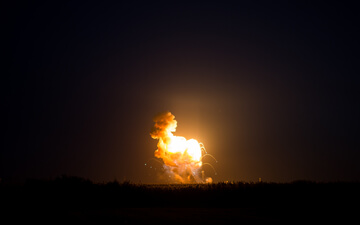Universe Today correspondent Ken Cramer reports on the moments of horror in the press stand of the launch site in Wallops, where the disaster occurred. NASA promises that the astronauts will have something to eat and the Russians deliver

Seconds after what appeared to be an impressive launch, a failure occurred in Orbital Sciences' Antares commercial rocket and it exploded into an impressive aerial fireball above the launch pad at NASA's Wallops Space Flight Facility on the Eastern Shore of Virginia, causing the resupply spacecraft to crash of the International Space Station, on Tuesday, October 28.
The Hunter rocket, which is as tall as a 14-story building, took off at 18:22 p.m. Launch 0A on the Atlantic coast at NASA's Wallops Center on its fifth launch.
Antares carried the Cygnus spacecraft that Orbital developed with its own money, and which contained an air-compressed payload loaded with approximately 2,200 kg of scientific experiments, research equipment, supplies for crew members, spare parts, equipment for walking a computer shuttle and other equipment intended for the space station as part of the Orb mission. 3. It was the heaviest payload ever brought to the station by a Cygnus spacecraft. About 100 kg more compared to previous flights. This was made possible by using for the first time a more powerful ATK CASTOR 30XL engine in the second stage of the rocket.
Messenger of the Universe Today website Covered the launch from the press vantage point located about 3 kilometers from the launch. "Everything functioned well at first, but within about five seconds it was clear that there was a serious problem when the missile stopped going up. He just froze in time. I looked directly at the launch pad, not through the tracking system of the cameras."
"You could tell that something was wrong when the missile climbed slowly and barely left the launch pad as it seemed to me. The missile did not come out of the huge plume of smoke and ash that is usually moved away by a device for absorbing these flames at the base of the launch pad."
"I tried to understand what happened because everything went wrong. It was different from all the Hunter launches I had seen from the press site. As a journalist and scientist I knew that I was watching a disaster unfold before my eyes. Instead of going in an ever-accelerating arc into the sky, a huge ball of fire, smoke and ash exploded and covered the whole sky before our eyes like a picture from a war movie. Literally the sky was on fire unlike anything I had ever seen.”
"The series of explosions in the air shocked the area. I felt the waves of the page and slight but noticeable heat waves passing through the place where we were sitting. Then the rocket began to fall back to Earth. After that, the ground also exploded when the fragments of the missile hit the ground and exploded with a tremendous noise in all directions."
"At this point the NASA people who accompanied us shouted at us to abandon everything on the spot and immediately run to the buses to clear the area. The ground fire spread mainly to the northern part of the launch pad and aerial plumes of fire also blew north. The ground fire was still burning half an hour later."
"Fortunately we all got out safe and sound thanks to the good NASA attendants who are trained for just these kinds of unexpected circumstances."
"It breaks my heart to see that such great efforts were made until the time of launch, and in some cases people worked for years to ensure the essential supplies for the space station and in particular for the scientific experiments it was built for." Kramer concludes.
NASA: We and Orbital Science: We will investigate the happenings
William Gerstenmeyer, NASA Assistant Administrator for Manned Flight and Operations, issued a statement about the damage caused by Launch 0A at the Wallops Launch Center in Virginia, during the launch attempt of the Antares rocket and the Cygnus payload spacecraft at 18:22 on Tuesday, October 28.
"While NASA is disappointed that Orbital Sciences' third supply launch to the International Space Station was not successful today, we will continue to move forward to the next attempt when we understand in detail what caused today's malfunction. Space station crew members are not at risk of running out of food supplies or other essential supplies."
"Orbital showed amazing capabilities on the first two missions to the space station earlier this year and we know they can replicate that success. Launching missiles is indeed a complicated operation and we learn from every success and every setback. Today's launch attempt will not prevent us from expanding the successful ability we have to launch cargo from US shores to the International Space Station."
Nevertheless, the astronauts have something to eat - a Russian supply spacecraft that took off safely
The astronauts found one comfort in the fact that today (Wednesday), a Russian supply spacecraft - Progress 57 - was sent to them from Kazakhstan. The spacecraft is filled with 3 tons of food, water, oxygen fuel and other supplies for the 41st crew members currently staying on the station.
